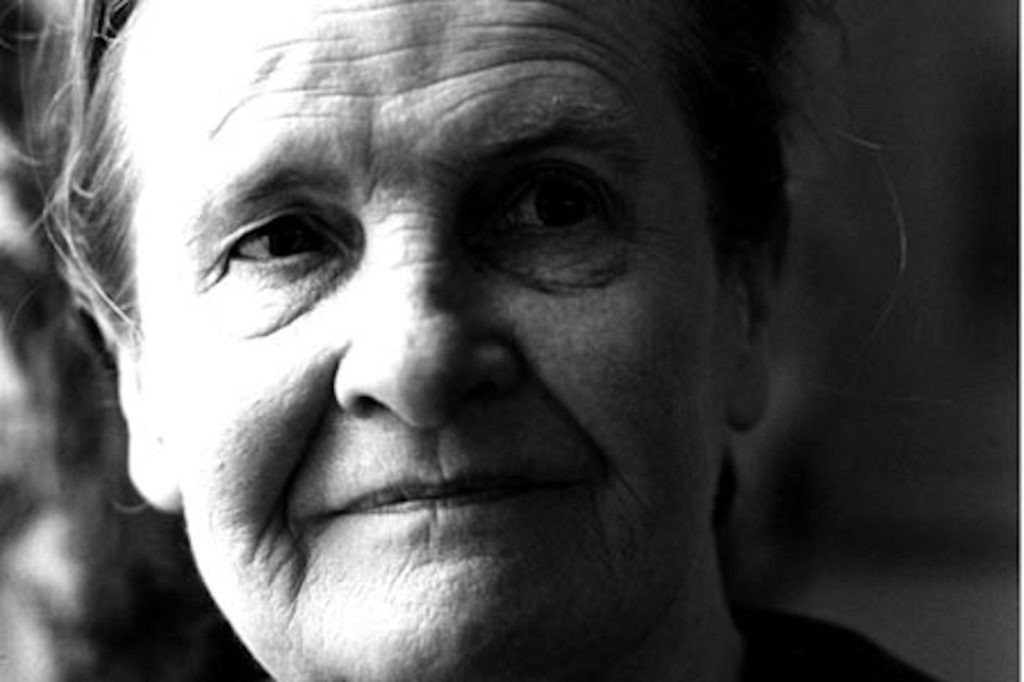Elizabeth Anscombe, born 100 years ago today, was one of the true giants of twentieth-century philosophy. Among her Catholic and neo-Aristotelian devotees, Anscombe is celebrated for lighting the flame of modern virtue ethics with her 1958 paper “Modern Moral Philosophy,” and for her defense of Catholic teaching in her well-known essay “Contraception and Chastity.”
But this is not consistent with her reputation elsewhere. Among most analytic philosophers, she is primarily remembered for her contributions to action theory (in particular, her monograph Intention) and to the philosophy of language. For readers of this sort, Anscombe’s insistence on the existence of intrinsically evil actions like contraception can come off as being too theologically inspired.
Yet a careful reading of Anscombe’s work suggests that her philosophical legacy cannot be divided up neatly into “Catholic” and “analytic” parts. In truth, both aspects of her work are deeply intertwined. The result is an extraordinarily rich synthesis of thinkers as diverse as Aquinas and Wittgenstein. To understand this unusual achievement, it is first necessary to understand Anscombe’s attitude that analytic philosophy—with its focus on logic and language rather than propositions of a more ethereal nature—is more method than doctrine.
Anscombe shows us that it is possible to rise above the cleavage in modern thought between the logical and the transcendental. And she does so particularly through her philosophy of the human person—her study of our spiritual nature and our special dignity—which pervades the rest of her work.
Start your day with Public Discourse
Sign up and get our daily essays sent straight to your inbox.For Anscombe, to search for the spiritual is not necessarily to engage in abstract metaphysical speculation about the nature of the soul. It is, rather, to look at commonplace experiences we often take for granted—such as thought, our sense of morality, and our intentional actions—in order to understand this twofold truth: that material facts do not disclose the whole truth about ourselves, yet they somehow point us to the presence of the spiritual. And that is because our material nature is an embodiment of our rationality.
Man is Spirit
“[M]an is spirit. He moves in the categories of innocence and answerability and desert—one of the many signs of a leap to another kind of existence from the life of the other animals.” So Anscombe writes in a paper on euthanasia. But how do we know that man has a spiritual nature? Is this the same thing as one’s mind?
It is tempting to answer such questions in a Cartesian fashion. Cartesians think of mind as a wholly separate substance from the body, a kind of “immaterial matter, a refined ethereal medium” in which thinking takes place, writes Anscombe in her paper “Analytical Philosophical and the Spirituality of Man.” But this, Anscombe contends, is not the right way forward.
The Cartesian view has been so influential that the notion of thought is often readily identified with conscious thought—when a distinct mental event occurs in one’s consciousness. Anscombe does not deny the existence of such private, inner thoughts, but she reminds us that they are not the only or even the most important manifestation of our spiritual nature.
Instead, thought is better conceived of as a capacity. After all, we perform all kinds of activities—speaking, writing, fixing things, making tea—that surely involve and require rational thought. Yet these activities do not always or consistently require particular thought-events in our consciousness in order to be performed.
Hence, to think of man as a rational animal is not to imagine some strange thinking substance within the outer case of the body. For one can look to the body to “see someone thinking something.” Anscombe gives the example of someone doing a jig-saw puzzle, whose behavior clearly expresses the thought, “Perhaps it’ll fit in this place, but the other way round.” What this is not is a claim about what thoughts are going on inside his head as he maneuvers that piece of the puzzle. (He may well be thinking about supper, or about Cartesian philosophy!) The point, rather, is that our material behavior embodies thought.
The Unity of Body and Soul
How, otherwise, could someone point to the shape of something, as opposed to its color, when this distinction cannot be found in one’s physical behavior alone? (This question was first posed by Wittgenstein in the Philosophical Investigations, though Anscombe takes it up again.) Such an act of pointing, as we have seen, is not necessarily accompanied by a conscious thought of its intention.
Anscombe calls such a phenomenon “an act of man qua spirit,” for it gives us a sort of paradigm for the concept of spirit. Our reflection on the fact that no bodily activity as such could be the act of pointing to shape, as opposed to color, shows us that matter alone does not disclose the whole truth of human life. Such considerations thus help us to appreciate the traditional articulation of the relationship between our bodies and our spiritual nature that is found in Aquinas’s Summa Theologiae: that the soul is to the body as form is to matter (“form” in the Aristotelian sense of that which organizes and shapes matter internally, as its principle of operation). It is not a kind of “motor” that moves the body from one place.
Aquinas writes that the soul, as form, is present in every part of the body—even the parts of the human body that move without our control. But it is particularly when intentional acts of the body, such as pointing or completing jig-saw puzzles, disclose immaterial realities of thought that we perceive this intimate union of body and soul more clearly.
Hence, Anscombe’s exposition of the spiritual through ordinary behavior helps to demystify Aquinas’s metaphysics, which can sound quaint to modern ears. Her philosophy leads us on a path of humane self-understanding, for the notion of body-soul union is in turn significant for certain practical aspects of Anscombe’s thought, such as our knowledge of moral value, and the meaning of “intention.”
Connatural Moral Knowledge
Regarding moral knowledge, Anscombe shares with Aquinas a sense that we grasp the most basic of moral precepts or values through inclination or instinct. This is an idea particularly associated with the natural law, and Anscombe indeed uses the Thomistic term “connatural knowledge” to refer to this phenomenon. In other places, she seems to refer to the same idea with the phrase “mystical perception.” Here, “mystical” does not mean something highly esoteric, but rather indicates the presence of “supra-utilitarian” value.
This sense of the mystical helps us see what is truly at stake with moral prohibitions. Anscombe suggests it is rather “comic” to justify the prohibition of murder in a purely utilitarian way (i.e., that it is valuable simply because it is useful in keeping social order). All of us are, in fact, capable of perceiving the gravity of extinguishing a human life—we recognize a “supra-utilitarian” value to life, an intrinsic goodness that cannot be reduced to utilitarian considerations.
Hence, for Anscombe, the most important form of connatural moral knowledge is our sense of the dignity of human nature. No doubt, she speaks of other instances of connatural knowledge as well, such as reverence for the sexual act and the valuing of the knowledge of biological parenthood.
What grounds our special dignity—and our knowledge of it—is none other than the nature of our body-soul union. In her paper “The Dignity of the Human Being,” Anscombe writes, “Remember that we are intellectual animals, whose vegetative and animal life is part of a life framed by our intellectuality.” Bodily activities like eating and sexual reproduction are not sub-rational. On the contrary, they are intrinsically bound up with the goods of our rational or spiritual nature, such as love of God and of neighbor.
Not only does this mean the whole human being is imbued with a special dignity, it also means we do not learn of this dignity externally, as it were, via deductive arguments. An implication of the unity of body and soul is that we are inclined from within to value the goods towards which our bodily nature tends. So Anscombe suggests that it is our rationality informing the bodily exercise of our sexuality, for example, that leads us to a certain sense of “awe before procreation and pregnancy.” This awe is surely not merely aesthetic, but also moral—it is a mystical perception of the goodness of begetting new life.
Such connatural knowledge certainly does not render superfluous the cultivation of virtue. But it gives us a starting point, a basic sense that, say, human life, or the knowledge of one’s parentage, is good because it is in accord with our nature as beings of embodied rationality.
Intention in Action
Another practical implication of our body-soul union for Anscombe’s philosophy is found in her analysis of “intention.” All too often, this concept is regarded as being primarily about inner mental states. But since bodily actions can be expressive of thought, for Anscombe, intention is more paradigmatically about action—actions to which a certain sense of the question “Why?” applies.
To understand this “certain sense,” we might return to Anscombe’s discussion of pointing to shape rather than color. Following Wittgenstein, Anscombe explains that one way of understanding such an action is to look at its context. Does the person pointing possess the concepts of shape and color? Is there something being accomplished in this context by pointing to shape, such as the teaching of a word? So the spiritual act of pointing to an object’s shape is not constituted by a single event, but rather by a series of events.
This idea that we can understand an action by attending to the narrative elements surrounding it is foundational to Anscombe’s work on intention. An intention is not necessarily an interior thought about what I hope to achieve through a particular action. An action is also intentional when it can be explained or interpreted by past history—for example, by the motive of revenge—or by context. These are all possible applications of that “certain sense” Anscombe speaks of. An intention is therefore more like the underlying meaning of an action in the context of human institutions and history.
This is why “intention” is best understood in light of our body-soul union. One must attend to both material and immaterial aspects of activities—what it means to supply someone goods, for instance, cannot be understood simply by observing physical facts, or by asking what interior thought accompanied the action. It is our participation in established human institutions, such as our systems of finance and commerce, that makes an action like delivering potatoes to someone’s house, in the appropriate context, intelligible as an act of supplying.
Tying intention too exclusively to interior thought would have grave consequences for ethics. If intention could be a matter of a “private ceremony,” then a president signing an order for a nuclear attack, for example, could absolve himself of guilt by simply saying in his mind, “I am only intending to sign the paper.” Such an approach would be a corruption of the principle of double effect. The institutional context, constituted by both material (e.g. pen and paper) and immaterial (e.g. legal authority) elements, surrounding the act of signing means it is inescapably an intentional act aimed at killing.
Man is spirit, but he is also body, and this truth has important implications for our lives. Because it reminds us that the spiritual is not something completely alien to the physical, Anscombe’s philosophy offers us a much-needed antidote to the materialism of our times. To search for the spiritual is not to look somewhere obscure, but to look at the everyday facts of human life, institutions, and history. Man and his actions cannot be understood as purely material—nor does he truly understand himself that way. For he has an instinctual grasp of the mystical, which, as Anscombe says, is “as common as humanity.”














